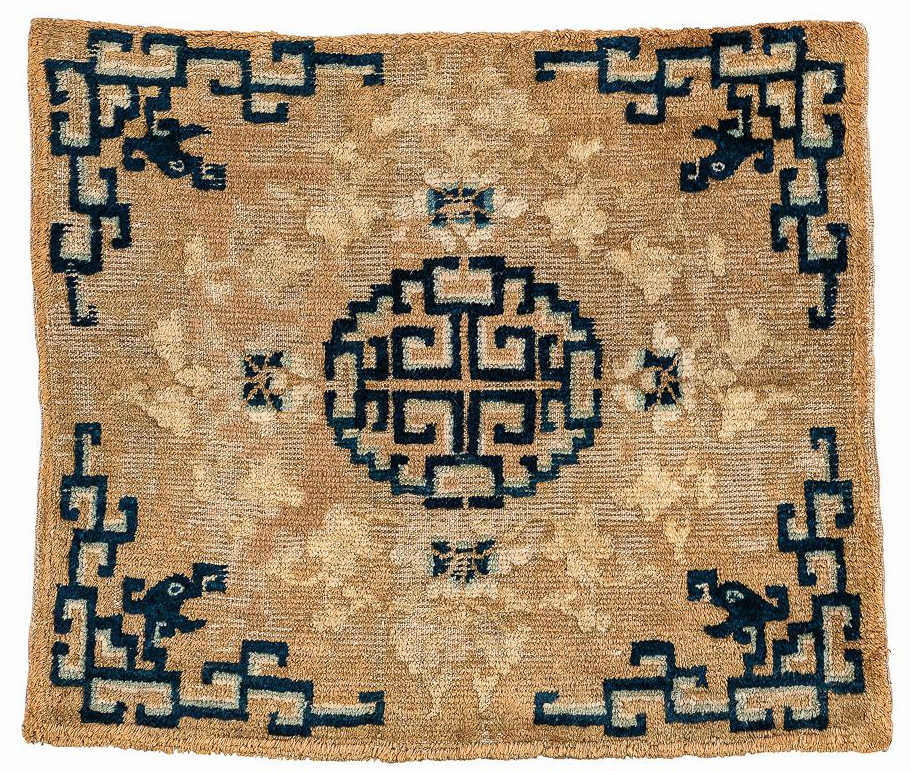Ningxia
(Ninghsia) small dragon and lotus rug, Kangxi (K'ang Hsi) Period, circa
1700-1720
Code: NXKG01J
Age: early XVIII century
Size:
74x86cm
Size (ft): 2'5"x2'10"
Structure
and materials: Wool pile on a cotton foundation. Asymmetrically
knotted wool pile open to the left
Description: The best and rarest examples of early
Ningxia rugs were woven during the Kangxi period, when carpets began to
achieve a status comparable to other forms of decorative art.
This
rare Kangxi period rug, probably used as a seat cover, is decorated with
a fret medallion which is encased by a
cloud collar shape made of lotuses and vinery.
There are four lotuses (symbol of
purity), one in each cardinal direction. The fret is an abstract
representation of the dragon. The four corners
have fret and dragon head corner guards. The seat-cover has no
borders or surround.
The dragon is a recurrent motif in Chinese
decorative arts, becoming prominent initially in the Han dynasty (206BC -
AD220). They are associated with Imperial authority and with the nature of
the universe and were thought to embody the same dynamic forces that
animated clouds and vapours. Franses, op cit, p.16 notes that almost half
the surviving Imperial Wanli carpets depict dragons, and that these are
generally quite naturalistic in appearance; their sinuous bodies are
covered in scales; limbs and facial features are clearly recognisable. In
the pieces produced in Ninghsia in the reign of Emperor Kangxi, the dragon
continues to be an important motif, but their style of depiction changes,
taking three primary forms:
- in the first they are drawn in an
archaic manner, recalling their depiction in the Han dynasty, where their
snake-like trunks issue multiple branches which split into vapour scrolls,
whilst their heads remain recognisably dragon-like;
- in the second
their heads remain recognisable, whilst their bodies are formed of
interlocking fretwork;
- in the third fretwork alone is used to
symbolise the dragon.
Franses, ibid, notes these three forms
appear concurrent. Interestingly, there is a pair of Beijing Imperial
carpets, illustrated König. H., Franses. M., Gnz de Himmelssöhne,
Kaiserliche Teppiche aus China 1400 – 1750, Museum für Ostasiatische
Kunst, Köln, exhibition
catalogue, London, 2005, p. 60, cat. 3, (dated
to the last quarter of the 16th century), in which the dragons are
archaistic, possibly the prototypes for the sinuous Ninghsia dragons.
Formerly in Sandra Whitman's collection.
Good condition for
its age. Some wear and a few re-piling areas in the field. Ends bound.
References: Seat-covers of similar age and design can be seen:
-Lorentz, A View of Chinese Rugs from the Seventeenth to the Twentieth
Century, plate 24
- Franses, Glanz der Himmelssohne, Kaiserliche
Teppiche Aus China 1400-1750, plates 19 and 20 pp. 118-119.
- Hali
Magazine, 144, page 78 & 83
|

